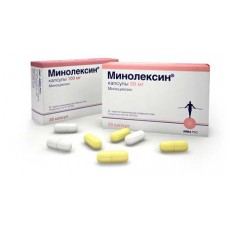Expiration date: 01/2025
Composition
Active substance: minocycline hydrochloride (based on minocycline) 100 mg,
auxiliary substances: microcrystalline cellulose, low molecular weight povidone, potato starch, magnesium stearate, lactose monohydrate.
Packaging
20 PCs.
Pharmacological action
Minoleksin is a semisynthetic antibiotic of tetracycline group. Bacteriostatic effect on the cells of sensitive strains of microorganisms due to reversible inhibition of protein synthesis at 30S ribosomal subunit. It has a wide range of antibacterial activity.
The sensitivity of the microorganisms:
Some of the microorganisms shown below showed resistance to minocycline, so it is recommended to conduct laboratory before use . the study of sensitivity. Antibiotics of tetracycline group are not recommended for treatment of streptococcal and staphylococcal infections if sensitivity is not shown
microorganisms to minocycline.
Aerobic gram-positive: Bacillus anthracis, Listeria monocytogenes, Staphylococcus aureus, Streptococcus pneumoniae.
Aerobic gram-negative: Bartonella bacilliformis, Brucella species, Calymmatobacterium granulomatis, Campylobacterfetils, Francisella tularensis, Haemophilus ducreyi, Vibrio cholerae, Yersinia pestis.
Indications
Minoleksin is used to treat the following diseases, provided the sensitivity of pathogenic microorganisms:
- Acne
- Skin infection
- Spotted fever, typhus fever, typhoid fever, fever Ku (Coxiella), vesicular rickettsiosis, and tick-borne fever
- Infection digitalnih ways
- The lymphogranuloma venereum
- Ornithosis
- Trachoma (infectious keratoconjunctivitis)
- Conjunctivitis with inclusions (paratrahome)
- Negonokokkovi urethritis, infections of the cervical canal and anus in adults
- Cyclic fever
- Chancroid
- Plague
- Tularemia
- Cholera
- Brucellosis
- Bartonellosis
- Inguinal granuloma
- Syphilis
- Gonorrhea
- Frambesia (tropical granuloma, nonvenereal syphilis)
- Listeriosis
- Anthrax
- Angina Vincent
- Actinomycosis
In the case of acute intestinal amebiasis, minocycline may be used as a Supplement to amebicidal drugs.
In severe acne. minocycline can be used as an additional therapy.
Oral minocycline is indicated for asymptomatic carriers of Neisseria meningitidis for eradication of meningococci from the nasopharynx.
Contraindications
- Hypersensitivity to minocycline, tetracycline and other components of the drug
- Porphyria
- Severe hepatic and renal failure
- Leukopenia
- Pregnancy
- Breast feeding
- Systemic lupus erythematosus
- Children up to age 8 years (the period of development of the teeth)
- Simultaneous treatment with isotretinoin
- Lactase deficiency, lactose intolerance, glucose-galactose malabsorption
Caution: impaired liver and kidney function, concomitant use with hepatotoxic drugs.
Method of application and doses
Inside, after eating. It is recommended to wash down with sufficient amount of liquid (can be milk). reduces the risk of irritation and ulceration in the esophagus.
The initial dose Minoleksin is 200 mg (2 capsules of 100 mg or 4 capsules of 50 mg), then take 100 mg (1 capsule of 100 mg or 2 capsules of 50 mg) every 12 hours (twice a day).
The maximum daily dose should not exceed 400 mg.
Infections of the genitourinary system and anogenital area caused by chlamydia and Ureaplasma: 100 mg (1 capsule of 100 mg or 2 capsules of 50 mg) every 12 hours for 7-10 days.
Inflammatory diseases of the pelvic organs in women in the acute stage: 100 mg (1 capsule of 100 mg or 2 capsules of 50 mg) every 12 h, sometimes in combination with cephalosporins.
Primary syphilis in patients. with povyshennoj sensitivity to penitsillinam: 100 mg (1 capsule of 100 mg or 2 capsules of 50 mg) twice a day for 10 - 15 days.
Gonorrhoea: 100 mg (1 capsule of 100 mg or 2 capsules of 50 mg) twice a day for 4-5 days, or once 300 mg.
Uncomplicated gonococcal infections (excluding urethritis and anorectal infections) in men: initial dose - 200 mg (2 capsules of 100 mg or 4 capsules of 50 mg), podderzhayushaya - 100 mg (1 capsule of 100 mg or 2 capsules of 50 mg) every 12 hours for a minimum of 4 days, followed by microbiological assessment of recovery 2-3 days after discontinuation of the drug.
Uncomplicated gonococcal urethritis in men: 100 mg (1 capsule of 100 mg or 2 capsules of 50 mg) every 12 hours for 5 days.
Acne: 50 mg (1 capsule of 50 mg) per day, a long course of 6-12 weeks.
Side effect
From the digestive system: anorexia, nausea, vomiting, diarrhea, dyspepsia, stomatitis, glossitis, dysphagia, dental enamel hypoplasia, enterocolitis, pseudomembranous colitis, pancreatitis, inflammatory
lesions (including fungal) in the oral cavity and the anogenital region, hyperbilirubinemia, cholestasis, an increase in the content of "hepatic" enzymes, hepatic insufficiency, including terminal hepatitis, including autoimmune.
On the part of the genitourinary system: candidiasis vulvovaginitis, interstitial nephritis, dose-dependent increase in the content of urea in blood plasma.
From the skin: baldness, nodular erythema, pigmentation of nails, itching, toxic epidermal necrosis, vasculitis, macular-papular and erythematous rash, Stevens-Johnson syndrome, exfoliative dermatitis, balanitis.
From the respiratory tract: shortness of breath, bronchospasm, asthma exacerbation, pneumonia.
From the musculoskeletal system: arthralgia, arthritis, limited mobility and swelling of the joints, change the color of bone, muscle pain (myalgia).
Allergic reactions: urticaria, angioneurotic edema, polyarthralgia, anaphylactic reactions (including shock), anaphylactoid purpura (schönlein Purpura), pericarditis, exacerbations of systemic lupus erythematosus, pulmonary infiltration accompanied by eosinophilia.
Organs of hematopoiesis: agranulocytosis, hemolytic anemia, thrombocytopenia, leukopenia, natrosilite, pancytopenia, eosinopenia, eosinophilia.
From the Central nervous system: convulsions, dizziness, numbness (including limbs), inhibition, vertigo, increased intracranial pressure in adults, headaches.
From the sensory organs: tinnitus and hearing impairment.
From the metabolic: Thyroid gland: a single case of malignant neoplasms, the color change (the results of patho-morphological studies), infringements of function.
Other: changing the color of the oral cavity (tongue, gums, palate), change the color of tooth enamel, fever, color secretions (eg, sweat).
Drug interaction
Preparations of tetracycline group reduce prothrombin activity of blood plasma, which may cause the need to reduce the doses of anticoagulants in patients undergoing anticoagulant therapy.
Due to the fact that bacteriostatic drugs affect the bactericidal action of penicillins, simultaneous administration of drugs penicillins and tetracyclines groups should be avoided.
Absorption of tetracyclines is impaired while taking antacids containing aluminum, calcium, magnesium or iron preparations, which can lead to a decrease in the effectiveness of antibiotic therapy.
There were cases of terminal renal toxicity while receiving methoxyflurane and drugs group
tetracyclines'.
Simultaneous use of antibiotics tetracycline group and oral contraceptives can reduce the effectiveness of contraception.
Avoid taking isotretinoin immediately before, simultaneously and immediately after taking minocycline, since both drugs can cause benign intracranial pressure.
Simultaneous reception of preparations of group of tetracyclines with ergot alkaloids and their derivatives increase the risk of ergotism.
Overdose
Symptoms: most often there are dizziness, nausea and vomiting.
Treatment: Selective antidote for minocycline is currently unknown. In case of overdose, it is necessary to stop taking the drug, provide symptomatic treatment and supportive therapy. Hemo-and peritoneal dialysis remove minocycline in small quantities.
Storage conditions
In a place protected from moisture and light, at temperatures. e do not exceed 25°C. Keep out of reach of children.
Shelf life
2 years.


